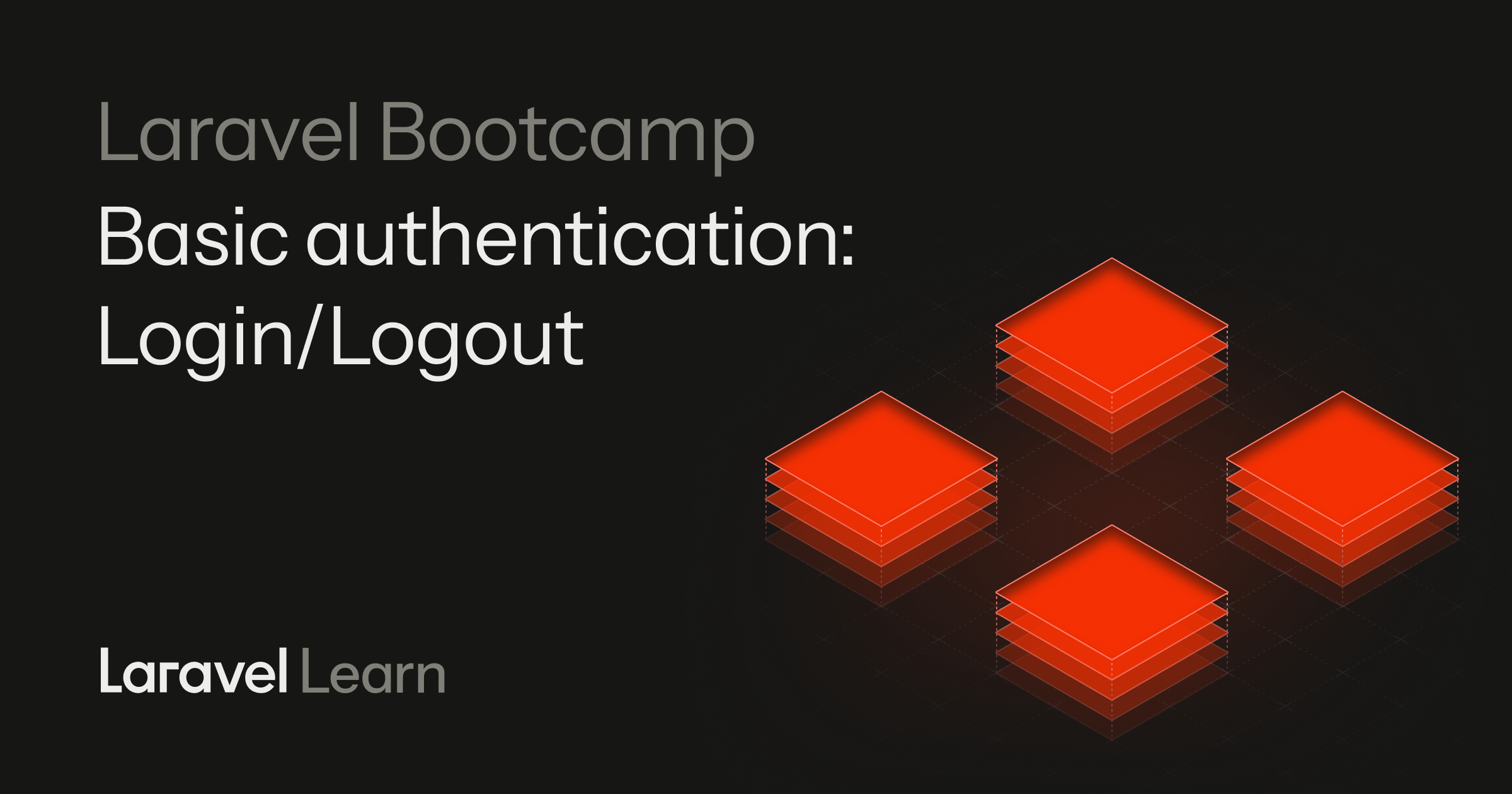00:00
We're finally going to make use of the sign in and sign up button
00:03
first in this lesson, the sign in.
00:05
So we've been pretending that we can, uh, edit or delete any chirp that is added.
00:11
And right now, anytime we add a new one, it's just an anonymous
00:16
person creating this chirp.
00:18
Laravel offers complete authentication scaffolding with Laravel starter kits,
00:22
but it's also helpful to know how to manually build it first, understand
00:26
how things work under the hood.
00:28
So let's start off by creating a new page.
00:30
So we have our chirps directory where we have our edit page, so it makes sense to
00:34
do a new directory that is an off page.
00:37
So why don't we do off and then we'll have a register, blade dot php.
00:42
Lemme paste in this code for us now the majority of things that
00:45
we're seeing here are not new.
00:47
We've seen them throughout our time together.
00:50
We have a slot where we're saying, this is the register page.
00:53
We're using a layout.
00:54
We're using a bunch of different forms.
00:57
We're gathering any errors that we might have.
01:00
We're showing those error messages, and then we're using
01:02
old inputs if we have any errors.
01:05
So again, not much new, but let's see what this looks like.
01:08
Let's go ahead and attach it to our web routes.
01:11
Just to keep things simple.
01:12
For now, let's go ahead and say route view, and this is the slash
01:18
register page, but this is our
01:21
auth register view.
01:23
Now let's go ahead and make sure in our layout, we are actually directing to
01:27
the slash register page and we are not.
01:30
So let's do that slash register.
01:32
Oops slash register in the signup.
01:36
So sign up slash register.
01:38
This is creating a new account.
01:41
Everything looks good.
01:41
So we have a name, we have an email and a password, and a
01:45
confirmation of a password.
01:46
Just while I'm here, why don't I make this the slash login route.
01:50
Now we do need to register a user.
01:52
When they complete this form.
01:53
We could create a new, maybe authentication controller, but what
01:59
we're going to do is kind of split this up into different controllers.
02:03
We're going to use PHP Artisan Make Controller,
02:07
and here's where we're going to go against the green just a little bit.
02:11
Instead of saying that this is a auth controller or a register controller
02:16
even, I'm going to say that this is the auth slash register controller.
02:21
And this should be a Invocative controller.
02:24
What this looks like is a single controller created in the auth
02:28
space, so slash http auth, and then register controller.
02:36
And what this looks like is a single class, an invo controller, which
02:41
just means that usually you only have one method per controller.
02:45
Instead of having a resource controller that has multiple, in
02:49
this case, seven different methods.
02:52
So really something like this versus something like this is personal
02:56
preference, but I did want to show two different ways that you might do it.
03:00
So that way everything that we're doing within auth, we're going to
03:03
have invo controllers instead of one massive, uh, authentication controller
03:08
that has weirder method names, because we don't necessarily have an.
03:13
Update method when it comes to authentication, we don't necessarily have
03:16
a show method or an edit method, so this is just a different way of doing this,
03:22
but we just pretend that this invoke is whatever method we normally would use
03:26
in our chirp controller, for example.
03:28
But this is just our register.
03:31
Auth controller, and when we call it, it's going to use this invocative function,
03:36
So almost identical to any other method or form that we've done.
03:40
I'm pasting this in.
03:41
We need to pull in the user model and we're going to pull in the hash support
03:48
facade as well as the auth facade.
03:51
Here's what's happening.
03:52
We're going to validate the input.
03:54
We're going to get the name, the email, the password.
03:56
We're making sure it's confirmed, and that's what that password
03:59
confirmation field that we have is.
04:02
We're going to create the user with a hash of that particular password.
04:08
And then we're going to log in, the user redirecting to the
04:11
home with a status of success.
04:14
Welcome to Charper.
04:16
It looks like this shouldn't be as easy as it is, right?
04:20
But it is mostly because of the helper methods that Laravel provides.
04:23
Not just the authentication helper method to be able to log in the user
04:27
that we just created, but also things like a hash to make passwords secure.
04:31
And because we already have a user model that's given to us outta the box
04:36
within Laravel, even if we don't have a starter kit that we started with,
04:40
this just becomes incredibly easy to get a register controller or any sort
04:45
of authentication up and running.
04:47
Why don't we add this to our web route?
04:50
So in addition to our view, we're going to add a post route, route
04:54
post of register, and we're going to pass in that register class.
05:00
You can see here that it's grabbing that auth register controller.
05:03
Now there's something I want to add right now.
05:05
Why don't we say that this is the register routes, so that way we know
05:10
and it's easy to see them at a glance.
05:12
But I do want to say that these routes should be able to be accessed by
05:16
anyone, even if they're not logged in.
05:18
This is where middleware comes into play, and Laravel has Middlewares built
05:23
out of the box for us in this case for the register route, I want to make
05:27
sure that this is accessible by guests.
05:30
So we're gonna say this is a middleware of guests, and you can see here that we
05:34
have that middleware available to us.
05:37
And just for fun, I wanna show us what a named route looks like in this case.
05:41
We can pass in a name, and I'm gonna call this the register route.
05:46
And we can do the same thing with our post method as well.
05:49
We're gonna say that this is a middleware of guests.
05:53
And we don't necessarily need to name this because we're just
05:55
posting to the slash register route.
05:58
Using the Register Invo class that we just created.
06:01
This name helps us say, Hey, instead of knowing that it is the slash register
06:06
page, maybe we change this to slash uh, I don't know, new for some reason.
06:12
Well, then we automatically know that it's still under the named route of register.
06:17
We can actually update the navigation instead of this hre
06:21
to register to use a named route.
06:23
For example, instead of that HF of register, I can pass it this route.
06:27
And in here we might be able to see, yes, the register named route.
06:32
Code extension is doing a lot of heavy lifting right here.
06:35
Now I do wanna update this as well, because when we're logged in, we shouldn't
06:38
show the sign in and sign up page.
06:41
Well, that's where the at auth parameter, or the at auth
06:45
directive, I should say, comes in.
06:47
So instead of the sign in and sign up, we can say, okay, well if there is in this
06:53
case, if someone is authenticated into the application, then we're gonna show
06:57
the auth user's name and a logout button.
07:01
We'll set this up in a little bit.
07:02
Otherwise, let's show the buttons like we had them previously.
07:06
What does this look like?
07:07
We have the signup button that still works even with our named route.
07:10
Let's go ahead and sign up Josh.
07:13
Register, welcome to Chi.
07:16
And you can see here that we have my name.
07:18
Log out's not going to work because we haven't created that route just yet.
07:22
So, just so we aren't stuck with this particular user that's logged in, why
07:26
don't we create that logout route?
07:28
We're gonna create a new controller, PHP Artisan Make Controller.
07:33
This is the auth slash logout controller.
07:38
We'll say it's invoke.
07:40
Now in this logout invo controller, it's gonna be the inverse
07:43
of what we did for register.
07:45
We're going to grab the user with the request user.
07:48
Then with the off facade, we're just gonna say, Hey, let's
07:51
log out that particular user.
07:53
We're passing in that user variable, and then we can return a redirect
07:58
with another success message.
07:59
You've successfully logged out.
08:02
Let's add this to our web routes.
08:04
So route post of logout, and again, that's what we're doing in our layout where we
08:09
are creating a form, a method of post to the action of logout, and the CSRF.
08:16
And that's exactly what that button is going to do.
08:19
When we hit that logout button, we are going to call this route post of Logouts
08:26
and that logout class, that Invocative controller that we just created.
08:30
I'm using the middleware of auth, and this is to show that yes, there are
08:34
multiple Middlewares that Laravel gives outta the box, and auth is one of 'em.
08:38
So in this logout option right here, what we're doing is saying, okay,
08:43
only someone who is authenticated can actually hit this logout button.
08:47
Of course, we have that in our layout here with auth as well.
08:53
So now hitting logouts and yeah, we successfully logged out.
08:57
I can't sign back in because we haven't yet implemented that, but
09:00
let's go ahead and protect the rest of our routes and update our
09:04
controllers to use our user now.
09:07
We can actually group routes with middleware.
09:09
What we can do here is route middleware.
09:12
We can say, this is the auth middleware.
09:14
We're going to group everything in this with a function, and we're going to
09:19
say that, Hey, um, within this whole route middleware group, I want to
09:24
grab everything and put this in there.
09:27
Now, uh, everything that we see here is now.
09:32
Under the middleware auth.
09:34
So I can't send a new chirp now unless I am authenticated.
09:39
So what does this look like?
09:40
Well, if I try to send a chirp hi there, and I hit chirp, what
09:43
do you think is going to happen?
09:45
Well, Laravel gives you something out of the box that, because it
09:48
knows you're not authenticated, it's going to try to authenticate you.
09:53
And yeah, we don't have a login route to find, which is the default redirection
09:58
that Laravel gives when you do not have an authenticated user and you
10:02
try to hit a specific, uh, route that uses the auth middleware, that's okay.
10:08
We know it's working.
10:09
Let's go ahead and update our chirp controller, because here now we're
10:12
not just creating a new chirp.
10:13
We are actually creating a new chirp with our users.
10:16
Why don't we do that?
10:17
Within this store method,
10:19
we're going to use the auth helper, and we can say that the user of this
10:23
auth helper, we want to get their chirps, but we want to create them.
10:29
And so we can actually create them with that validated parameter.
10:32
Now my editor is going to give me an error that this method of user is not defined,
10:37
but rest assured, this is correct.
10:40
And then since we set up that policy in order to authorize a user to update a
10:45
particular chirp, we can add that here.
10:47
Now, this authorize, if they are authorized to update the
10:51
chirp, then let's continue.
10:53
And same thing with the edit form as well.
10:56
And then same thing for the Destroy method as well.
10:59
And since we are authorizing a particular user in this update method,
11:03
well, we don't have to say, uh, we want the off users chirp to update
11:08
because we already know that they're able to update this particular chirp.
11:14
Same thing with being able to edit or view that edit page in general.
11:18
Now we still see these edit and delete buttons.
11:20
I am not logged in, but we've started to authorize if someone is able to do this,
11:25
if someone's able to edit or delete.
11:26
Now, if I tried to do this because we have that middleware, I should get an error.
11:32
The route login is not defined.
11:34
But how can we only show these edit and delete buttons when we
11:37
are able to edit and delete this?
11:39
And the chirp blade PHP component for these edit end buttons.
11:43
Let's go ahead and change this.
11:45
We are going to say if the auth check exists in this case, if
11:49
they are authenticated and if the auth ID is equal to chirp user id,
11:55
and actually there's an easier way to do this as well with a blade directive.
11:59
Instead of this, if off check and off ID is equal as it the chirp user id.
12:03
Okay, that's, oh, that's great.
12:06
But really we just need to check that policy that we created.
12:09
Can they update or can they delete a chirp?
12:12
And if they can update it, they can delete it.
12:15
So we can just use this blade directive of can, can they update the chirp
12:22
in this case, the chirp that we're passing in, and then the can directive.
12:27
The end can directive.
12:30
In this case, we cannot edit any of these, uh, and I cannot delete any of
12:35
them because I'm not logged in, but I'm going to sign up, create a new account,
12:38
and show you after I create a chirp that I can actually edit and delete them.
12:47
Looks like we have error messages out of the box.
12:56
Chirp, and look it, we have our user avatar associated with
13:01
us because we have logged in
13:02
and I can see the edit and delete methods I can edit and, uh oh.
13:07
Looks like we have an issue here.
13:11
Our controller probably has not used the authorization or being
13:15
able to use the authorization trait.
13:17
I don't believe I set that up.
13:19
So let's go to the chirp controller and if we want to use the this authorize,
13:24
what we can do is make sure this controller is set up to authorize.
13:28
Use authorizes requests that pulls in the Use Illuminate Foundation
13:34
Auth Access, authorizes requests Trait for this particular controller.
13:38
And now that we made that change, now our controller is using that
13:42
authorizes request straight.
13:44
We have the ability to have those authorization policies available so
13:47
we can edit the chirps that we create.
13:50
Edit my first chirp, edited, and update chirp.
13:56
And we can delete it.
13:57
Your chirp has been deleted.
13:59
Hopefully this shows you that authentication doesn't
14:02
have to be too scary.
14:04
Authentication within Laravel is actually incredibly easy because of
14:07
the tools that it provides, and while, yes, it's great, you can just grab
14:11
a starter kit from Laravel and you have authentication out of the box.
14:15
You don't necessarily need to do it every single time.
14:18
That being said, starter kits are great because they have a lot that
14:21
we're not going to even touch within chirp or such as password reset pages.
14:26
But last but not least, why don't we get the ability for users to log in because if
14:30
I log out, I can't sign back in just yet.
14:33
So let's do that in the next lesson.







